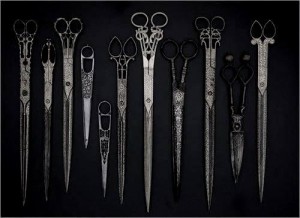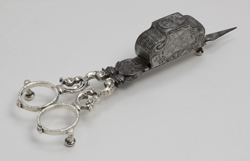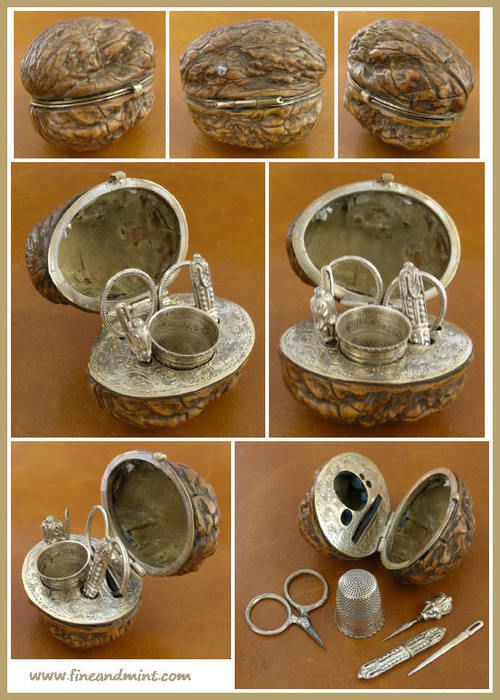What's Out There: Scissors
Since I’ve been sewing for quite a while, and my grandmother sewed, and my mom likes to go to antique-ing and yard-sale-ing, I have come into rather a lot of pairs of scissors. Or shears. It turns out that the difference between scissors and shears is blade size and handle type. While there isn’t quite an exact consensus, for the most part if the blades are over 6″ and the handles have a small hole in one handle for the thumb and a larger hole in the other handle for two or more fingers, then those are shears. Shorter blades and same-size handles are scissors. So if you told your family not to use your good scissors on paper, and they went ahead and used them anyway, they may get off on a technicality if it was your big pair.
The earliest scissors date back to the Bronze Age. These were really pre-scissors in that they were connected at one end and had a spring-like action. One of the first mentions of scissors as valuable household goods was in the bridal trousseau list of the Byzantine Emperor’s daughter in 1009 AD. We would think of them as sheep shears now, but that’s what people used for all-purpose scissors at the time. They were made in many sizes, but they didn’t change much until the Romanesque period, sometime between the 6th and 10th century.
 Both types of scissors continued to be used, however, modern scissors, with the two arms connected by a pin that pivoted the blades together, began to be improved upon and expanded. The modern pivoting scissors were in use all over the world. News must have travelled fast. There are Viking examples in the Historiska Museum in Stockholm. If you visit the Piacenza Cathedral in Italy, there is a depiction of modern scissors in the sculpture of the haberdashers’ guild dating back to 1112 AD.
Both types of scissors continued to be used, however, modern scissors, with the two arms connected by a pin that pivoted the blades together, began to be improved upon and expanded. The modern pivoting scissors were in use all over the world. News must have travelled fast. There are Viking examples in the Historiska Museum in Stockholm. If you visit the Piacenza Cathedral in Italy, there is a depiction of modern scissors in the sculpture of the haberdashers’ guild dating back to 1112 AD.

Scissors are fairly simple, but there are a number of designs that evolved over time to address a variety of uses. As the art of calligraphy spread throughout the Islamic world, scissors were decorated with engraving, and special concave blades were developed to most easily cut the parchment (very thin sheepskin) used for books. Scissors for cloth had a slightly angled blade. As the ability to decorate metal improved, scissors were increasingly decorated with engraving, fretwork, and sculpted in many unique designs.  One which we still see today is the stork with the bill as the scissors and the body in the handles. By the Fifteenth century, there were very specialized uses. Candle-trimmers were very common, and they had both a cutting edge to snip the wick, and also an attached box to catch the burnt ends. Trimming the wick provided a slower, steadier burn, and prevented smoking.
One which we still see today is the stork with the bill as the scissors and the body in the handles. By the Fifteenth century, there were very specialized uses. Candle-trimmers were very common, and they had both a cutting edge to snip the wick, and also an attached box to catch the burnt ends. Trimming the wick provided a slower, steadier burn, and prevented smoking.
 Since there was limited surface area for decoration, artists turned to decorating sheaths for the scissors. Sheaths made carrying small sharp objects in clothes pockets much easier. They could also be incorporated into chatelaines which held other household necessities. Sheaths also protected the blades from damage and could be made quite beautiful. They came in precious and decorated metals, leather, fabric, ivory, bone and wood. Some fit only over the end of the blades, some held the whole pair of scissors inside. Sometimes the sheath turned into an entire miniature sewing kit.
Since there was limited surface area for decoration, artists turned to decorating sheaths for the scissors. Sheaths made carrying small sharp objects in clothes pockets much easier. They could also be incorporated into chatelaines which held other household necessities. Sheaths also protected the blades from damage and could be made quite beautiful. They came in precious and decorated metals, leather, fabric, ivory, bone and wood. Some fit only over the end of the blades, some held the whole pair of scissors inside. Sometimes the sheath turned into an entire miniature sewing kit.


As with many beautiful tools of the past, with the rise of mass manufacturing, scissors once again became functional tools. I love my Gingher’s, but wouldn’t they be even more fun if they had a little jewelled case?
Happy Sewing!
Leigh Wheeler
President

